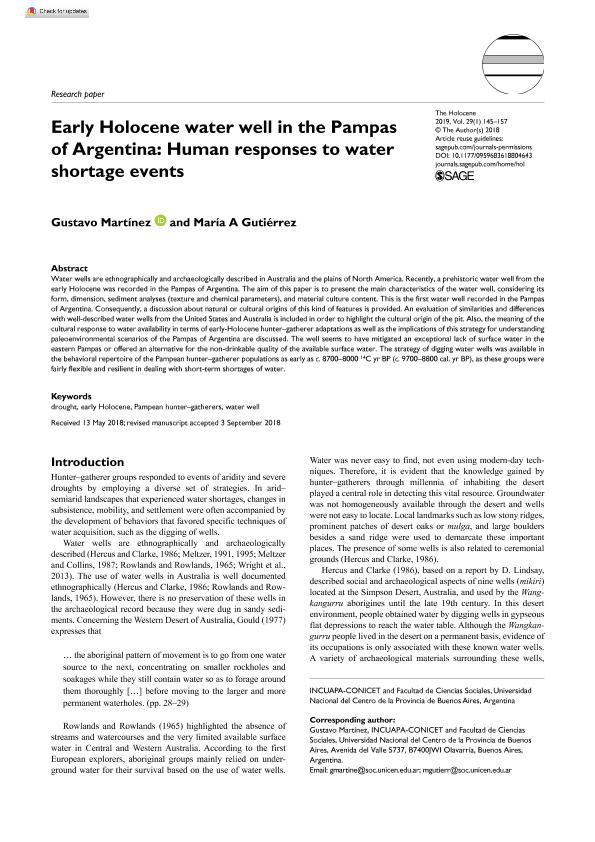Mostrar el registro sencillo del ítem
dc.contributor.author
Martinez, Gustavo Adolfo

dc.contributor.author
Gutierrez, Maria Amelia

dc.date.available
2020-12-15T12:58:33Z
dc.date.issued
2019-01
dc.identifier.citation
Martinez, Gustavo Adolfo; Gutierrez, Maria Amelia; Early Holocene water well in the Pampas of Argentina: Human responses to water shortage events; Sage Publications Ltd; Holocene (Seven Oaks); 29; 1; 1-2019; 145-157
dc.identifier.issn
0959-6836
dc.identifier.uri
http://hdl.handle.net/11336/120419
dc.description.abstract
Water wells are ethnographically and archaeologically described in Australia and the plains of North America. Recently, a prehistoric water well from the early Holocene was recorded in the Pampas of Argentina. The aim of this paper is to present the main characteristics of the water well, considering its form, dimension, sediment analyses (texture and chemical parameters), and material culture content. This is the first water well recorded in the Pampas of Argentina. Consequently, a discussion about natural or cultural origins of this kind of features is provided. An evaluation of similarities and differences with well-described water wells from the United States and Australia is included in order to highlight the cultural origin of the pit. Also, the meaning of the cultural response to water availability in terms of early-Holocene hunter–gatherer adaptations as well as the implications of this strategy for understanding paleoenvironmental scenarios of the Pampas of Argentina are discussed. The well seems to have mitigated an exceptional lack of surface water in the eastern Pampas or offered an alternative for the non-drinkable quality of the available surface water. The strategy of digging water wells was available in the behavioral repertoire of the Pampean hunter–gatherer populations as early as c. 8700–8000 14 C yr BP (c. 9700–8800 cal. yr BP), as these groups were fairly flexible and resilient in dealing with short-term shortages of water.
dc.format
application/pdf
dc.language.iso
eng
dc.publisher
Sage Publications Ltd

dc.rights
info:eu-repo/semantics/openAccess
dc.rights.uri
https://creativecommons.org/licenses/by-nc-sa/2.5/ar/
dc.subject
DROUGHT
dc.subject
EARLY HOLOCENE
dc.subject
PAMPEAN HUNTER–GATHERERS
dc.subject
WATER WELL
dc.subject.classification
Arqueología

dc.subject.classification
Historia y Arqueología

dc.subject.classification
HUMANIDADES

dc.title
Early Holocene water well in the Pampas of Argentina: Human responses to water shortage events
dc.type
info:eu-repo/semantics/article
dc.type
info:ar-repo/semantics/artículo
dc.type
info:eu-repo/semantics/publishedVersion
dc.date.updated
2020-06-08T15:33:32Z
dc.journal.volume
29
dc.journal.number
1
dc.journal.pagination
145-157
dc.journal.pais
Estados Unidos

dc.description.fil
Fil: Martinez, Gustavo Adolfo. Consejo Nacional de Investigaciones Científicas y Técnicas. Centro Científico Tecnológico Conicet - Tandil. Investigaciones Arqueológicas y Paleontológicas del Cuaternario Pampeano. Universidad Nacional del Centro de la Provincia de Buenos Aires. Investigaciones Arqueológicas y Paleontológicas del Cuaternario Pampeano; Argentina
dc.description.fil
Fil: Gutierrez, Maria Amelia. Consejo Nacional de Investigaciones Científicas y Técnicas. Centro Científico Tecnológico Conicet - Tandil. Investigaciones Arqueológicas y Paleontológicas del Cuaternario Pampeano. Universidad Nacional del Centro de la Provincia de Buenos Aires. Investigaciones Arqueológicas y Paleontológicas del Cuaternario Pampeano; Argentina
dc.journal.title
Holocene (Seven Oaks)

dc.relation.alternativeid
info:eu-repo/semantics/altIdentifier/doi/http://dx.doi.org/10.1177/0959683618804643
dc.relation.alternativeid
info:eu-repo/semantics/altIdentifier/url/https://journals.sagepub.com/doi/10.1177/0959683618804643
Archivos asociados
